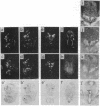Abstract
A number of vertebrate genes of the Dlx gene family have been cloned in mouse, frog, and zebrafish. These genes contain a homeobox related to that of Distalless, a gene expressed in the developing head and limbs of Drosophila embryos. We cloned and studied the expression of two members of this family, which we named Dlx5 and Dlx6, in human and mouse. The two human genes, DLX5 and DLX6, are closely linked in an inverted convergent configuration in a region of chromosome 7, at 7q22. Similarly, the two human genes DLX1 and DLX2 are closely linked in a convergent configuration at 2q32, near the HOXD (previously HOX4) locus. In situ hybridization experiments in mouse embryos revealed expression of Dlx5 and Dlx6 mRNA in restricted regions of ventral diencephalon and basal telencephalon, with a distribution very similar to that reported for Dlx1 and Dlx2 mRNA. A surprising feature of Dlx5 and Dlx6 is that they are also expressed in all skeletal structures of midgestation embryos after the first cartilage formation. The expression pattern of these genes, together with their chromosome localization, may provide useful cues for the study of congenital disorders in which there is a combination of craniofacial and limb defects.
Full text
PDF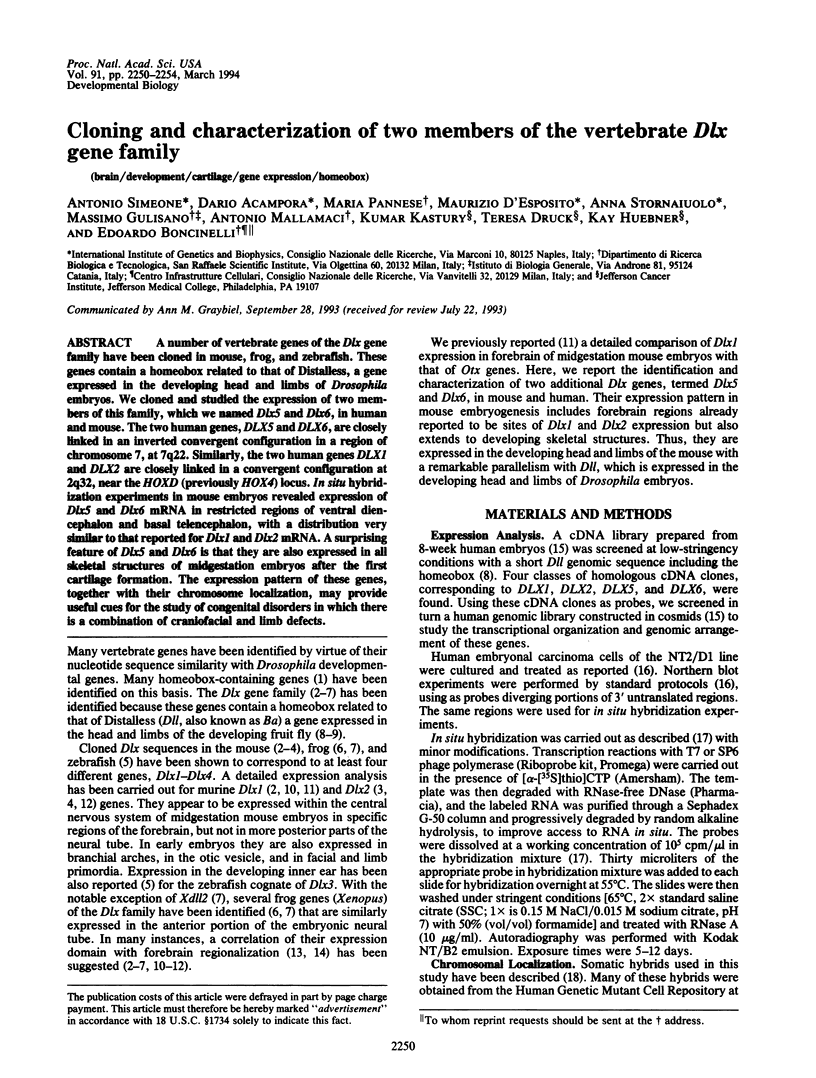
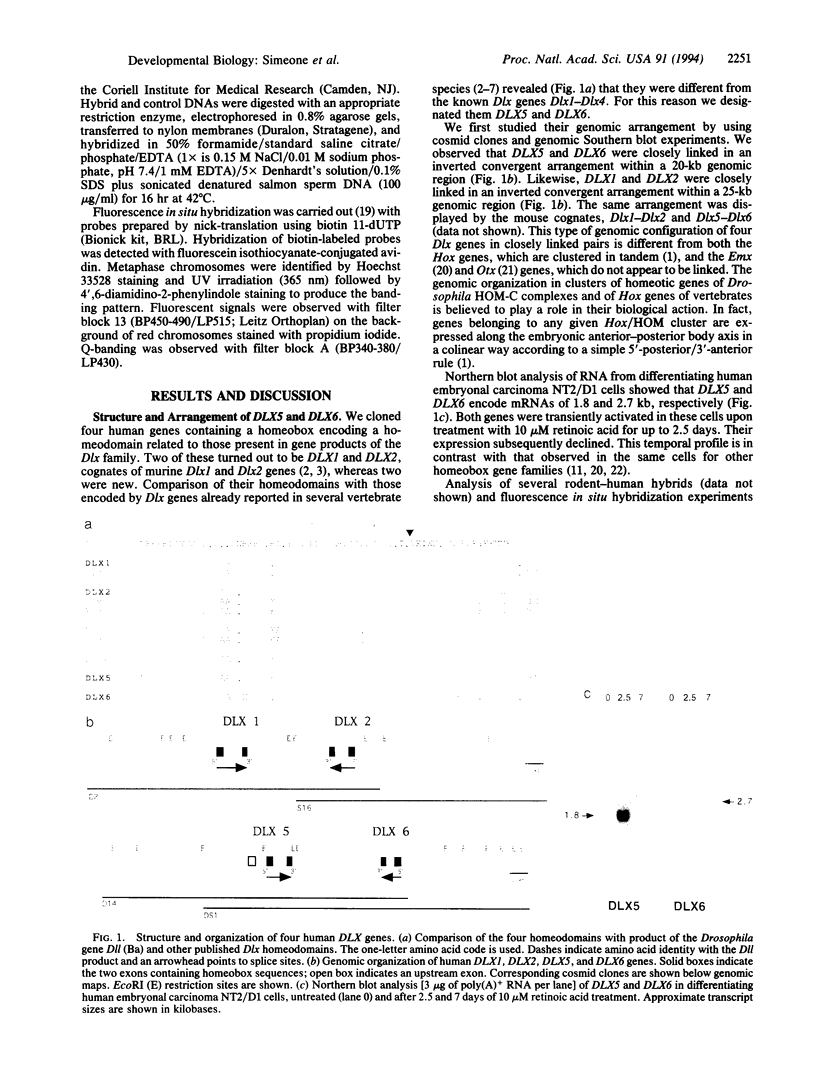
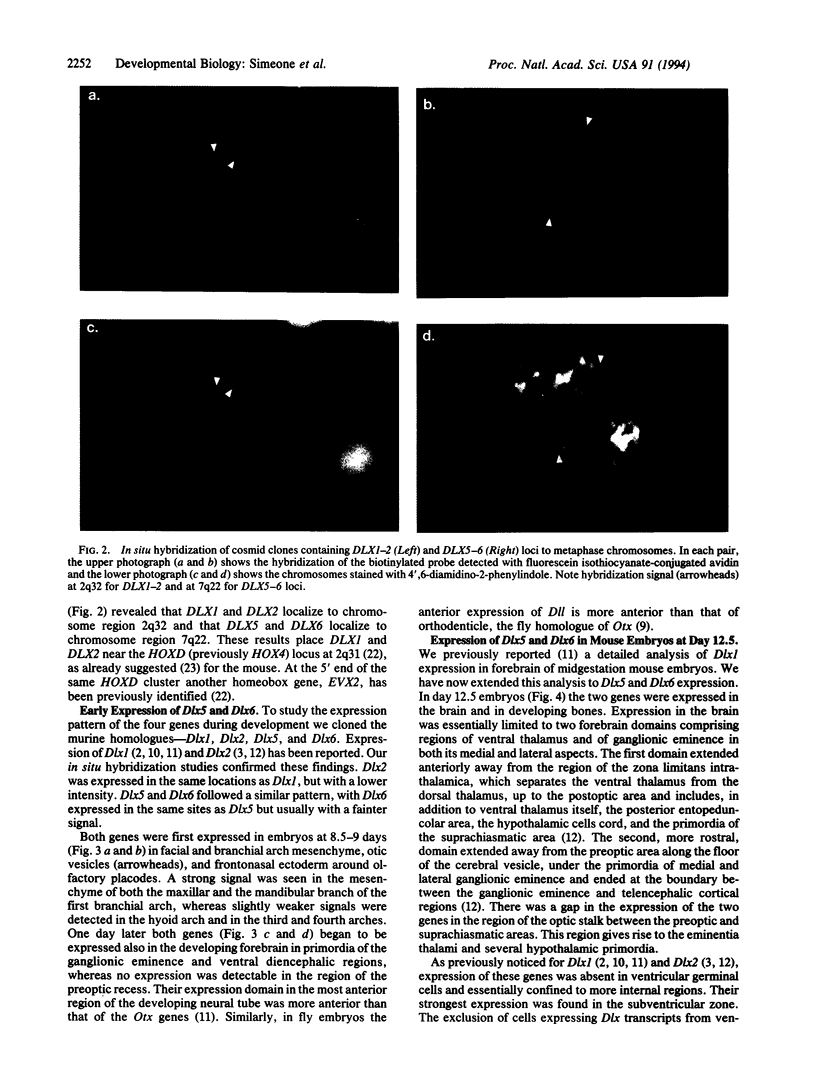
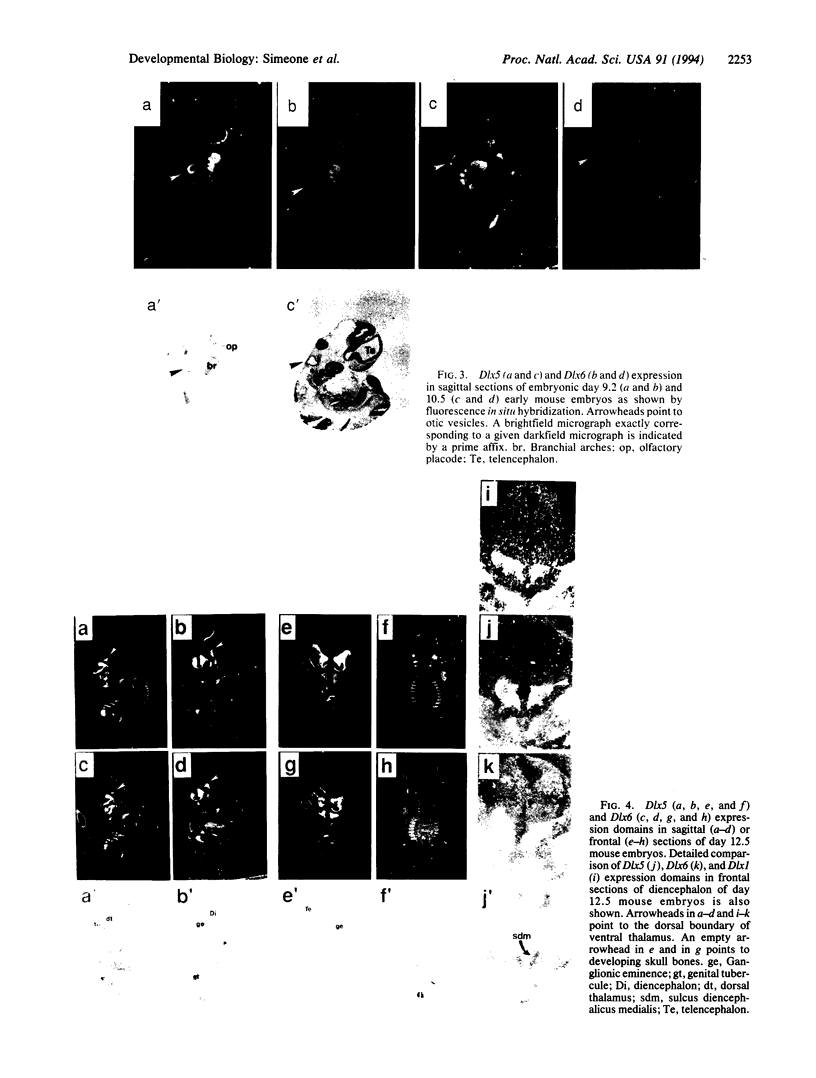
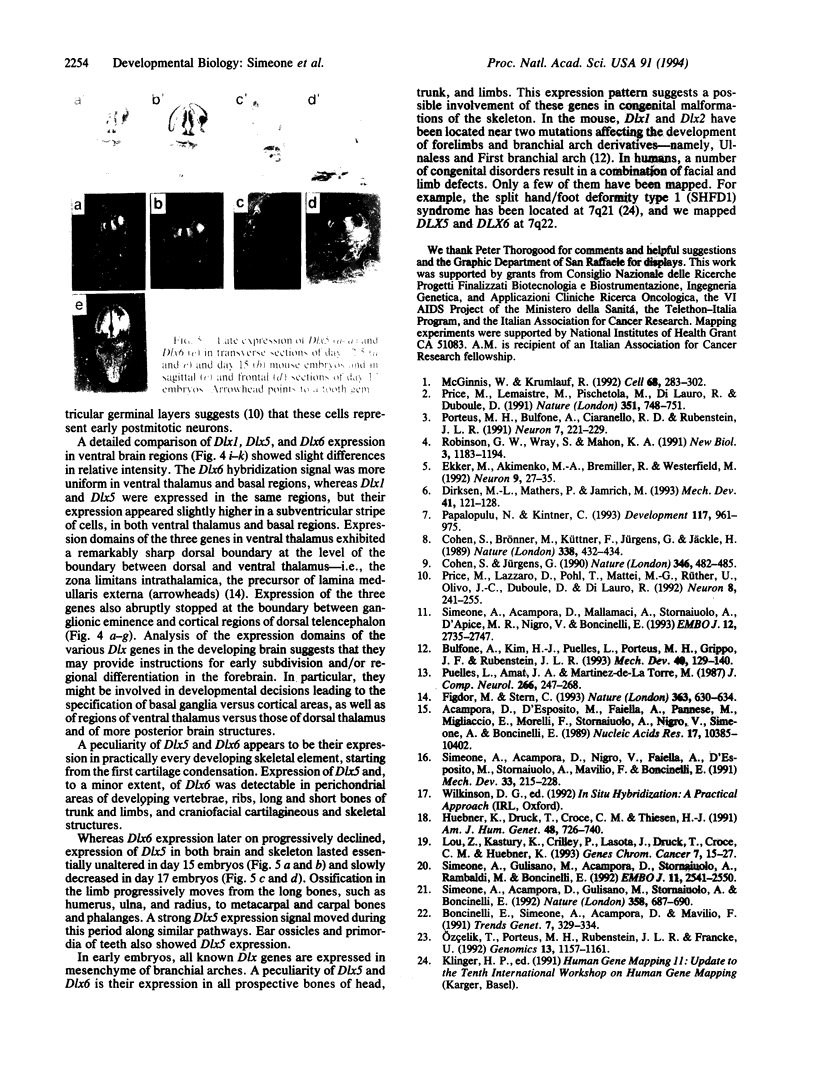
Images in this article
Selected References
These references are in PubMed. This may not be the complete list of references from this article.
- Acampora D., D'Esposito M., Faiella A., Pannese M., Migliaccio E., Morelli F., Stornaiuolo A., Nigro V., Simeone A., Boncinelli E. The human HOX gene family. Nucleic Acids Res. 1989 Dec 25;17(24):10385–10402. doi: 10.1093/nar/17.24.10385. [DOI] [PMC free article] [PubMed] [Google Scholar]
- Boncinelli E., Simeone A., Acampora D., Mavilio F. HOX gene activation by retinoic acid. Trends Genet. 1991 Oct;7(10):329–334. doi: 10.1016/0168-9525(91)90423-n. [DOI] [PubMed] [Google Scholar]
- Cohen S. M., Brönner G., Küttner F., Jürgens G., Jäckle H. Distal-less encodes a homoeodomain protein required for limb development in Drosophila. Nature. 1989 Mar 30;338(6214):432–434. doi: 10.1038/338432a0. [DOI] [PubMed] [Google Scholar]
- Cohen S. M., Jürgens G. Mediation of Drosophila head development by gap-like segmentation genes. Nature. 1990 Aug 2;346(6283):482–485. doi: 10.1038/346482a0. [DOI] [PubMed] [Google Scholar]
- Dirksen M. L., Mathers P., Jamrich M. Expression of a Xenopus Distal-less homeobox gene involved in forebrain and cranio-facial development. Mech Dev. 1993 May;41(2-3):121–128. doi: 10.1016/0925-4773(93)90042-v. [DOI] [PubMed] [Google Scholar]
- Ekker M., Akimenko M. A., Bremiller R., Westerfield M. Regional expression of three homeobox transcripts in the inner ear of zebrafish embryos. Neuron. 1992 Jul;9(1):27–35. doi: 10.1016/0896-6273(92)90217-2. [DOI] [PubMed] [Google Scholar]
- Figdor M. C., Stern C. D. Segmental organization of embryonic diencephalon. Nature. 1993 Jun 17;363(6430):630–634. doi: 10.1038/363630a0. [DOI] [PubMed] [Google Scholar]
- Huebner K., Druck T., Croce C. M., Thiesen H. J. Twenty-seven nonoverlapping zinc finger cDNAs from human T cells map to nine different chromosomes with apparent clustering. Am J Hum Genet. 1991 Apr;48(4):726–740. [PMC free article] [PubMed] [Google Scholar]
- Lou Z., Kastury K., Crilley P., Lasota J., Druck T., Croce C. M., Huebner K. Characterization of human bone marrow-derived closed circular DNA clones. Genes Chromosomes Cancer. 1993 May;7(1):15–27. doi: 10.1002/gcc.2870070104. [DOI] [PubMed] [Google Scholar]
- McGinnis W., Krumlauf R. Homeobox genes and axial patterning. Cell. 1992 Jan 24;68(2):283–302. doi: 10.1016/0092-8674(92)90471-n. [DOI] [PubMed] [Google Scholar]
- Ozçelik T., Porteus M. H., Rubenstein J. L., Francke U. DLX2 (TES1), a homeobox gene of the Distal-less family, assigned to conserved regions on human and mouse chromosomes 2. Genomics. 1992 Aug;13(4):1157–1161. doi: 10.1016/0888-7543(92)90031-m. [DOI] [PubMed] [Google Scholar]
- Papalopulu N., Kintner C. Xenopus Distal-less related homeobox genes are expressed in the developing forebrain and are induced by planar signals. Development. 1993 Mar;117(3):961–975. doi: 10.1242/dev.117.3.961. [DOI] [PubMed] [Google Scholar]
- Porteus M. H., Bulfone A., Ciaranello R. D., Rubenstein J. L. Isolation and characterization of a novel cDNA clone encoding a homeodomain that is developmentally regulated in the ventral forebrain. Neuron. 1991 Aug;7(2):221–229. doi: 10.1016/0896-6273(91)90260-7. [DOI] [PubMed] [Google Scholar]
- Price M., Lazzaro D., Pohl T., Mattei M. G., Rüther U., Olivo J. C., Duboule D., Di Lauro R. Regional expression of the homeobox gene Nkx-2.2 in the developing mammalian forebrain. Neuron. 1992 Feb;8(2):241–255. doi: 10.1016/0896-6273(92)90291-k. [DOI] [PubMed] [Google Scholar]
- Price M., Lemaistre M., Pischetola M., Di Lauro R., Duboule D. A mouse gene related to Distal-less shows a restricted expression in the developing forebrain. Nature. 1991 Jun 27;351(6329):748–751. doi: 10.1038/351748a0. [DOI] [PubMed] [Google Scholar]
- Puelles L., Amat J. A., Martinez-de-la-Torre M. Segment-related, mosaic neurogenetic pattern in the forebrain and mesencephalon of early chick embryos: I. Topography of AChE-positive neuroblasts up to stage HH18. J Comp Neurol. 1987 Dec 8;266(2):247–268. doi: 10.1002/cne.902660210. [DOI] [PubMed] [Google Scholar]
- Robinson G. W., Wray S., Mahon K. A. Spatially restricted expression of a member of a new family of murine Distal-less homeobox genes in the developing forebrain. New Biol. 1991 Dec;3(12):1183–1194. [PubMed] [Google Scholar]
- Simeone A., Acampora D., Gulisano M., Stornaiuolo A., Boncinelli E. Nested expression domains of four homeobox genes in developing rostral brain. Nature. 1992 Aug 20;358(6388):687–690. doi: 10.1038/358687a0. [DOI] [PubMed] [Google Scholar]
- Simeone A., Acampora D., Mallamaci A., Stornaiuolo A., D'Apice M. R., Nigro V., Boncinelli E. A vertebrate gene related to orthodenticle contains a homeodomain of the bicoid class and demarcates anterior neuroectoderm in the gastrulating mouse embryo. EMBO J. 1993 Jul;12(7):2735–2747. doi: 10.1002/j.1460-2075.1993.tb05935.x. [DOI] [PMC free article] [PubMed] [Google Scholar]
- Simeone A., Acampora D., Nigro V., Faiella A., D'Esposito M., Stornaiuolo A., Mavilio F., Boncinelli E. Differential regulation by retinoic acid of the homeobox genes of the four HOX loci in human embryonal carcinoma cells. Mech Dev. 1991 Mar;33(3):215–227. doi: 10.1016/0925-4773(91)90029-6. [DOI] [PubMed] [Google Scholar]






